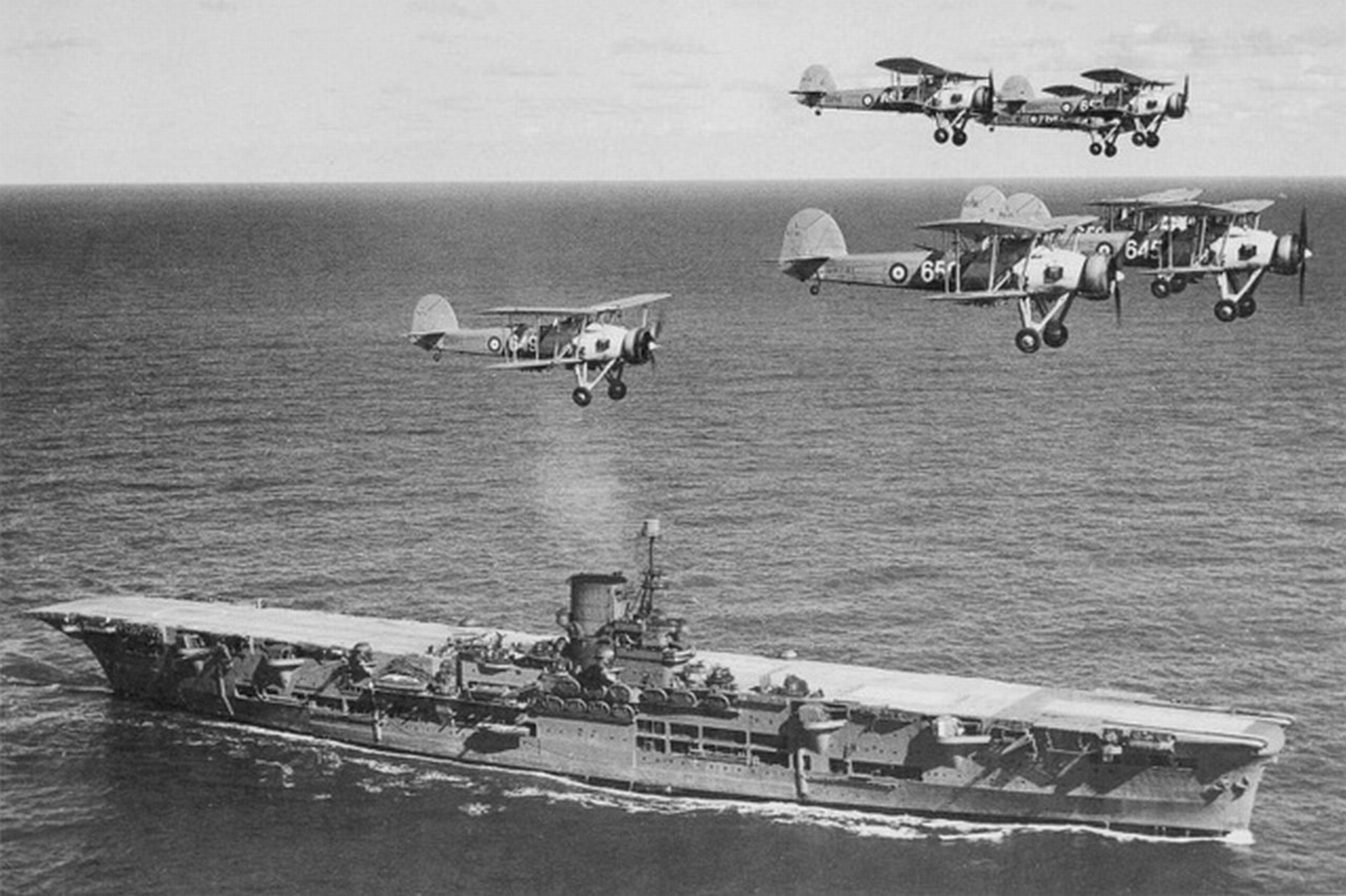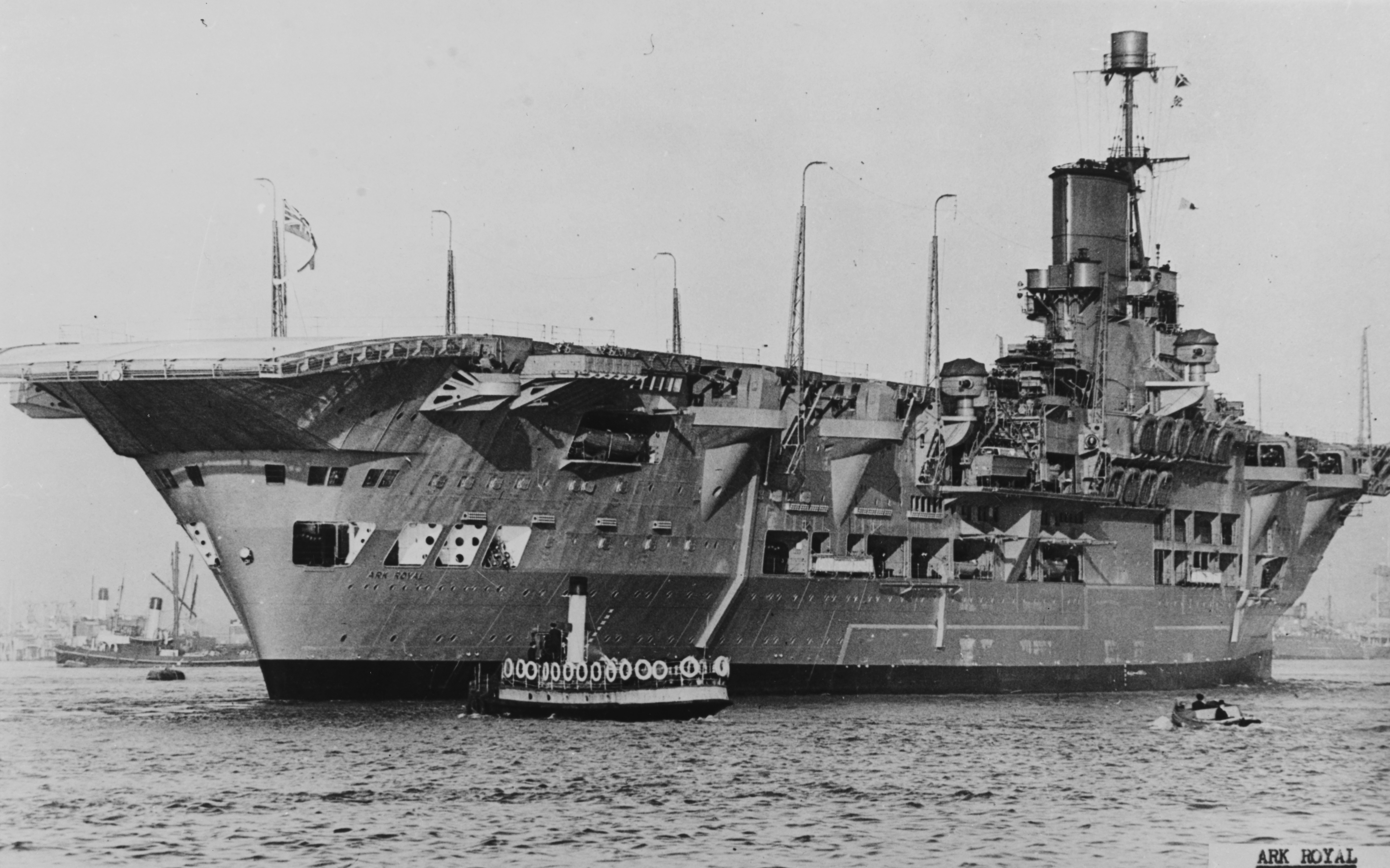
HMS Ark Royal, the third Royal Navy warship to bear that name, was unique in many respects. First and foremost, she was the first aircraft carrier constructed with the flight deck and hangers as an integral part of the ships structure, rather than welded on a pre-existing superstructure as was the case previously. She was instrumental in the sinking of the German Battleship Bismarck, and was the flagship of Force H, under Admiral Sir James Somerville, Royal Navy.

The deteriorating international situation by 1933, typified by Germany's rearmament and Japan and Italy's expansionist aims, convinced the British government to allocate funds to resume the long-delayed construction programme.
Funding was announced in the 1934 budget proposals, and plans for the new carrier were finalised by November 1934. The plans were tendered in February 1935 to Cammell Laird and Company, Ltd., which calculated that the cost of the hull would come to £1,496,250, while the main machinery would cost approximately £500,000. The overall cost was estimated to be over £3 million, making Ark Royal the most expensive ship by then ordered by the Royal Navy. Construction began on Job No. 1012 when Ark Royal’s keel was laid down on 16 September 1935.
Ark Royal spent nearly two years in the builder's yard before being launched on 13 April 1937 by Lady Maud Hoare, wife of Sir Samuel Hoare, then First Lord of the Admiralty.
The bottle of champagne she threw against Ark Royal’s bows did not smash until the fourth attempt.
The carrier spent a year fitting out, was handed over to her first commander, Captain Arthur Power, on 16 November 1938, and was commissioned into the Royal Navy on 16 December. She was originally intended for service in the Far East, but events in Europe during her construction and fitting out, including the Italian invasion of Abyssinia in 1935 and the outbreak of the Spanish Civil War in 1936, caused the Admiralty to instead mark the carrier for deployment with the Home and Mediterranean Fleets.
After her crew joined her at the end of 1938, Ark Royal began an intensive period of trials and tests to prepare her for service with the Home Fleet. During these trials, Ark Royal proved capable of sailing above her theoretical speed, reaching over 31 knots, an astonishing speed for a warship of her size.

On 10 November, 1941, Ark Royal ferried more aircraft to Malta, before making the return voyage to Gibraltar. Admiral Somerville had been warned of U-boats operating off the Spanish coast and reminded the ships of Force H to be vigilant. Also at sea was Friedrich Guggenberger's U-81, which had received an intelligence report that Force H was expected to be returning to Gibraltar. At 15:40 hours, the sonar operator aboard the escorting destroyer HMS Legion detected an unidentified sound, but assumed it was the propellers of a nearby destroyer.

One minute later, Ark Royal was struck amidships by a single torpedo, between the fuel bunkers and bomb store, and directly below the bridge island. The impact and subsequent explosion caused Ark Royal to shake violently, hurled fully loaded torpedo-bombers into the air, and killed a man. A 130 feet (40 m) long by 30 feet (9.1 m) deep hole was created on the starboard side of the carrier, which allowed the starboard boiler room, main switchboard, oil tanks, and over 106 feet (32 m) of the ship's starboard bilge to flood immediately. The starboard power train was knocked out, causing the rear half of the ship to lose power, while communications were severed shipwide.

HMS Legion moves alongside the damaged and listing HMS Ark Royal in order to take off survivors.
Immediately after the torpedo strike, Captain Maund attempted to order the engines to full stop, but had to send a runner to the engine room when it was discovered communications were down. The hole in the hull was enlarged by the ship's motion, and by the time Ark Royal came to a stop she had taken on a considerable amount of water and began to list to starboard, reaching an angle of 18 degrees from centre within 20 minutes. Considering the lean of the carrier, as well as the fates of British aircraft carriers HMS Courageous and HMS Glorious, which had sunk rapidly with heavy loss of life, Maund gave the order to abandon ship. The crew were assembled on the flight deck to determine who would remain onboard to try and save the ship while HMS Legion came alongside to take off the rest of the crew; as a result, comprehensive damage control measures were not initiated until 49 minutes after the attack.
The flooding spread unchecked during this time, and was exacerbated by several covers and armoured hatches left open during the evacuation of the lower decks. Water spread to the centreline boiler room, which started to flood from below, and power was lost shipwide when the boiler uptakes became choked; Ark Royal had no backup diesel generators. About half an hour after the explosion, the carrier appeared to stabilise. Admiral Somerville, determined to save Ark Royal, ordered damage control parties back to the carrier before taking the battleship HMS Malaya to Gibraltar to organise salvage efforts. The damage control parties were able to re-light a boiler, restoring power to the bilge pumps. The destroyer HMS Laforey came alongside to provide power and additional pumps, whilst Swordfish aircraft from Gibraltar arrived to supplement anti-submarine patrols around the stricken carrier. The tug Thames arrived from Gibraltar at 20:00 hours and attached a tow line to Ark Royal, but progressive flooding caused the angle of list to increase rapidly. Water had reached the boiler room flat, an uninterrupted compartment running across the width of the ship, forcing the shutdown of the restored boiler.

Another photograph showing the degree of the list.
The angle of list reached 20 degrees between 02:05 and 02:30 hours, and when 'abandon ship' was declared at 04:00 hours, had reached 27 degrees. Ark Royal's entire complement had been evacuated to Legion by 04:30 hours; with the exception of Able Seaman Mitchell, there had been no fatalities. The 1,487 officers and crew were transported to Gibraltar. The angle of list reached 45 degrees before Ark Royal capsized and sank at 06:19 hours on 11 November. Witnesses reported that the carrier rolled to 90 degrees, where she remained for about three minutes before completely inverting. Ark Royal then broke in two, with the aft section sinking within a couple of minutes, followed quickly by the bow.
HMS Ark Royal sank just 30 miles from Gibraltar on November 14, 1941. Of 1575 Officers and men aboard, only one man died.

No comments:
Post a Comment